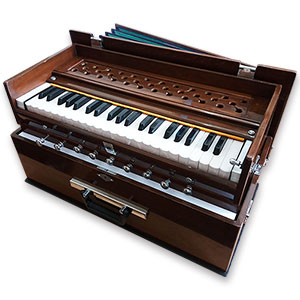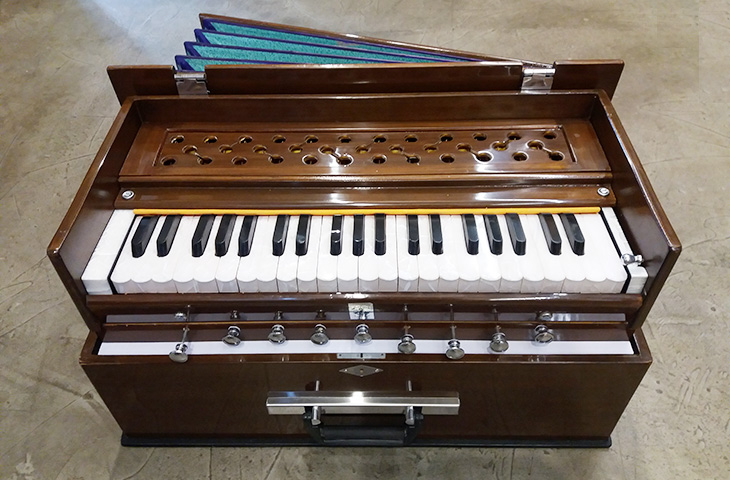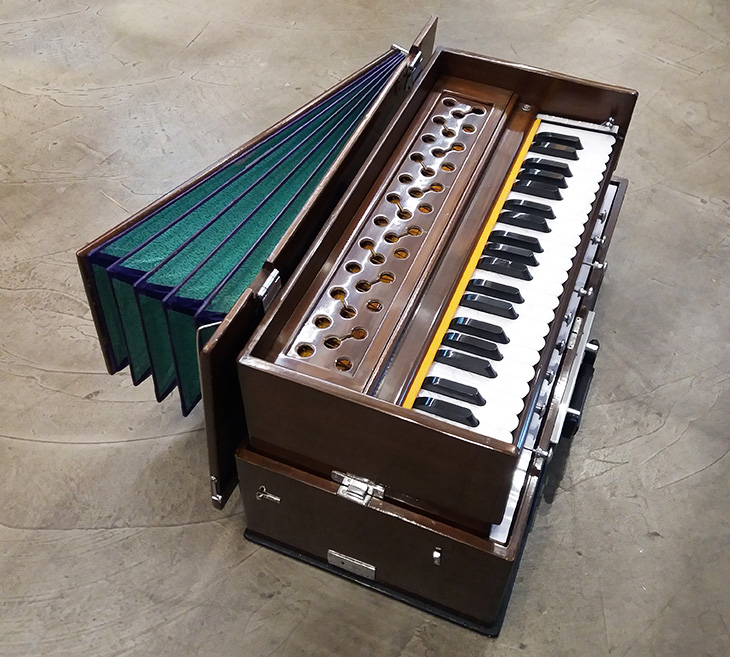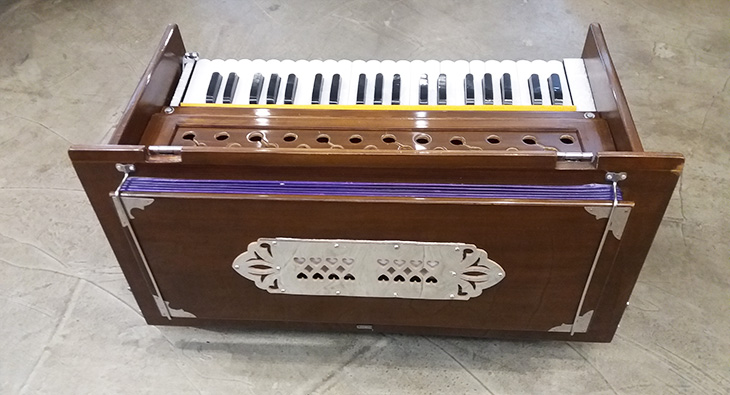- 지휘봉
- 오르프
- 휘슬/플릇
- 발도르프
- 하프
- 팬플릇
- 렌탈
- 신기하고 특이한
- 앙클룽
- 음악치료
- 교육
- 알프호른
- 세계전통
- 클래식타악기
- Sale
- 개별결제
- 선물용
10:00 ~18:00(월 ~토) info@euromusic.co.kr
-
[재입고완료]하모니움(Harmonium, Pump Organ) Portable

하모니움(Harmonium ; Peti ; Baja ; Pump Organ)

하모니움(Harmonium, Pump Organ)
하모니움은 상자형의 케이스와 피아노식의 건반을 가진 리드오르간의 일종입니다.
손으로 풀무(Bellows)에 바람을 넣어 건반을 연주하면 리드가 떨게 되어 소리를 만들어 냅니다.
스톱(Stops)은 음 빛깔을 변화시키는 장치입니다.


- ㆍ 옥타브: 3 1/2
- ㆍ 건반 수: 44
- ㆍ Reed Sets: Double(Bass & Male)
- ㆍ 9 Stops : - 5 Dain Stops
- - 4 Drone Stops
- 왼쪽 >> 오른쪽
1. Male reeds 2. C# Drone 3. Bass reeds 4.D# Drone
5. Bass reeds 6. G# Drone 7. Tremolo 8. A# Drone 9. Male reeds - ㆍ Coupler
ㆍ Travel Padded Soft Bag - ㆍ Notes: 2개
- ㆍ 무게: 7kg
- ㆍ Bellows: Multifold
- ㆍ 박스재질: 소나무
- ㆍ 시작 음: C

Bellows - The bellows are the pumps which force the air through the instrument. There are really two sets of bellows, one internal and one external. The external bellows are pumped by hand; these are familiar to the average player. The external bellows then forces the air into the internal bellows. The internal bellows act as a reservoir for the air. These bellows lay deep inside the instrument and are visible only by disassembling the instrument. The internal bellows push against a spring; it is this spring which forces the air over the reeds.
Keys - The keys, known in India as "chabi", are the small wooden controls that the performer fingers to play the music. There are black keys and white keys. Although the keyboard is reminiscent of the keyboards found on pianos and other Western instruments, the international standard for pitch (i.e., A=440) has not been adopted.
Cover - The cover is a small piece of wood, sometimes with cloth or glass, which covers the workings of the harmonium. It serves two functions. The most important is to protect the workings against damage. It also changes the sound by muting the higher frequencies while allowing the lower frequencies to pass. Sometimes the cover has a sliding panel which makes this muting action adjustable.
Stops (main) - The main stops are a series of valves which control the way that air flows in the instrument. The main stops control the air flowing into the various reed chambers. There are usually a minimum of one stop per reed chamber; however it is not unusual to find more than one per chamber. Although these extra stops may control special functions, such as tremolo, it is not unusual to find a redundant stops with no special function. This reflects the tendency of Indian musicians to simply open up all the stops, regardless of the function.
Stops (drone) - The drone strops are the most distinguishing feature of Indian harmoniums. These stops control the flow of air over un-keyed reeds. They simply drone their particular pitch. There may be any number of drones set to any pitch; however they tend toward, A sharp, C sharp, D sharp, F sharp, and G sharp.
Handles - The handles allow for easy transport of the harmonium. In a box type, there are two handles on the sides. In a suitcase style, there is only a single handle.
The harmonium is also known as peti or baja. This instrument is not a native Indian instrument. It is a European instrument which was imported in the 19th century. It is a reed organ with hand pumped bellows. Although it is a relatively recent introduction, it has spread throughout the subcontinent. Today, it is used in virtually every musical genre except the south Indian classical.
관련상품
교환/반품/환불/취소
배송정보
- 유럽악기는 CJ 대한통운 택배를 이용하고 있습니다. (CJ 대한통운택배: http://www.cjlogistics.com, 1588-1255)
- 평일 16시까지 입금완료시 당일 출고되며, 1~2일 후 수령하실 수 있습니다.
- (토요일은 출고를 하지 않습니다.)
(단,구매시- 배송비는 위 표에 따라 전국동일하게 적용되고, 교환이나 반품시- 제주도 및 도서산간지역은 실비로 청구됩니다.)
교환 및 반품, 환불 안내
- 품질보증기간은 구입일로부터 1년이며, 각 제품의 출시는 구입일로부터 6개월 이전입니다. (제조자/수입자: (주)한독인터네셔널/유럽악기)
- 제품을 받으신 후 교환 및 반품을 신청 하실 수 있는 기간은 제품의 특성상 7일 이내 입니다.
- 테스트 하셨거나 고객님의 부주의로 인해 상품의 가치가 훼손되었을 경우에는 반품 및 환불이 불가능합니다.
- (단, 제품 테스트 후에라도 제품에 하자가 있는 경우에는 교환처리가 됩니다.)
- 관악기는 입을 대는 것이므로 배송 완료 후 테스트 연주를 하지 않으셨어도 반품 및 환불이 불가능합니다.
- 고객님의 단순변심으로 인한 교환 및 반품시에는 왕복택배비(6,000원)를 부담해 주셔야 합니다.
- 교환 및 환불은 제품수거 후 상품의 상태여부를 확인하고 신속히 처리해 드립니다. (왕복 택배비 6,000원 고객님 부담. / 단, 제주도 및 도서산간지역은 실비청구됩니다.)
- 제품 A/S 발생 시 유럽악기 고객센터(02-522-0869)로 연락주시면 처리해 드립니다. (A/S비용 및 왕복 택배비 6,000원 고객님 부담.)
- 교환 및 반품 시 CJ대한통운만 가능합니다.

|
-
- 고객센터
- 02-522-0869
-
평일 09:30 ~ 18:30
토요일 10:00 ~ 18:00
-
- 입금계좌정보
-
국민 270901-04-033114
예금주: (주)한독인터네셔널
월~금 택배마감 16:00






